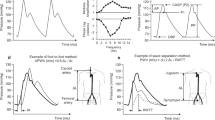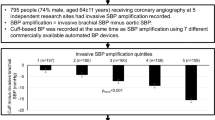Abstract
Aortic pulse wave velocity (AoPWV) and augmentation index (AIx) are commonly used measures of large elastic artery stiffness and wave reflection, respectively. Recently, a new cuff-based SphygmoCor device (Xcel) has been developed to measure both AoPWV and AIx. We sought to examine the following: (1) the validity of Xcel compared with the well-validated tonometry-based SphygmoCor device (MM3); (2) the intratest and day-to-day reliability of Xcel; (3) the influence of body side (right or left) on Xcel measurements; and (4) the relation of Xcel measurements to carotid artery compliance, distensibility and β-stiffness index. We found that measurements of AoPWV and AIx between Xcel and MM3 were not different (P=0.26 and P=0.43, N=22 and 26, respectively) and were strongly related (r=0.85 and 0.75, P<0.0001), and based on Bland–Altman plots there was good agreement between them. Intra-test (intraclass correlation=0.996 and 0.983, P<0.0001; AoPWV and AIx, N=24 and 26, respectively) and day-to-day reliability (intraclass correlation=0.979 and 0.939, P<0.0001) were high. Xcel AoPWV and AIx on the left versus right body side were not different (P=0.19 and P=0.58, N=14 and 15, respectively) and were highly correlated (r=0.99 and 0.94, P<0.0001). AoPWV and AIx measured with Xcel were positively related with β-stiffness index (r=0.62 and 0.51, P⩽0.005, N=23 and 24, respectively) and negatively related with distensibility (r=−0.58 and −0.44, P⩽0.02, N=23 and 24, respectively). In conclusion, Xcel measures of AIx and AoPWV are valid, highly reliable and not affected by body side. Xcel is a useful tool for use in research and the clinic.
This is a preview of subscription content, access via your institution
Access options
Subscribe to this journal
Receive 12 digital issues and online access to articles
$119.00 per year
only $9.92 per issue
Buy this article
- Purchase on Springer Link
- Instant access to full article PDF
Prices may be subject to local taxes which are calculated during checkout





Similar content being viewed by others
References
Vlachopoulos C, Aznaouridis K, O'Rourke MF, Safar ME, Baou K, Stefanadis C . Prediction of cardiovascular events and all-cause mortality with central haemodynamics: a systematic review and meta-analysis. Eur Heart J 2010; 31 (15): 1865–1871.
Vlachopoulos C, Aznaouridis K, Stefanadis C . Prediction of cardiovascular events and all-cause mortality with arterial stiffness: a systematic review and meta-analysis. J Am Coll Cardiol 2010; 55 (13): 1318–1327.
Pauca AL, O'Rourke MF, Kon ND . Prospective evaluation of a method for estimating ascending aortic pressure from the radial artery pressure waveform. Hypertension 2001; 38 (4): 932–937.
Adji A, Hirata K, Hoegler S, O'Rourke MF . Noninvasive pulse waveform analysis in clinical trials: similarity of two methods for calculating aortic systolic pressure. Am J Hypertens 2007; 20 (8): 917–922.
O'Rourke MF, Hashimoto J . Pressure pulse waveform analysis in critical care. Crit Care Med 2006; 34 (5): 1569–1570.
Casey DP, Beck DT, Nichols WW, Conti CR, Choi CY, Khuddus MA et al. Effects of enhanced external counterpulsation on arterial stiffness and myocardial oxygen demand in patients with chronic angina pectoris. Am J Cardiol 2011; 107 (10): 1466–1472.
Tanaka H, Dinenno FA, Monahan KD, Clevenger CM, DeSouza CA, Seals DR . Aging, habitual exercise, and dynamic arterial compliance. Circulation 2000; 102 (11): 1270–1275.
Armentano R, Megnien JL, Simon A, Bellenfant F, Barra J, Levenson J . Effects of hypertension on viscoelasticity of carotid and femoral arteries in humans. Hypertension 1995; 26 (1): 48–54.
O'Rourke MF, Staessen JA, Vlachopoulos C, Duprez D, Plante GE . Clinical applications of arterial stiffness; definitions and reference values. Am J Hypertens 2002; 15 (5): 426–444.
Hirai T, Sasayama S, Kawasaki T, Yagi S . Stiffness of systemic arteries in patients with myocardial infarction. A noninvasive method to predict severity of coronary atherosclerosis. Circulation 1989; 80 (1): 78–86.
Acknowledgements
We thank AtCor Medical for kindly providing the SphygmoCor Xcel device for the duration of the study. We also thank the study participants for their time and efforts.
Author information
Authors and Affiliations
Corresponding author
Ethics declarations
Competing interests
Dr Nichols has previously served as a consultant for AtCor Medical. All other authors declare no conflict of interest.
Rights and permissions
About this article
Cite this article
Hwang, MH., Yoo, JK., Kim, HK. et al. Validity and reliability of aortic pulse wave velocity and augmentation index determined by the new cuff-based SphygmoCor Xcel. J Hum Hypertens 28, 475–481 (2014). https://doi.org/10.1038/jhh.2013.144
Received:
Revised:
Accepted:
Published:
Issue Date:
DOI: https://doi.org/10.1038/jhh.2013.144
Keywords
This article is cited by
-
The acute effect of passively assisted trunk stretching on central arterial stiffness and blood pressure in middle-aged to older adults
European Journal of Applied Physiology (2024)
-
Functional capacity, physical activity, and arterial stiffness in patients with systemic sclerosis
Clinical Rheumatology (2024)
-
Blood pressure, arterial waveform, and arterial stiffness during hemodialysis and their clinical implications in intradialytic hypotension
Hypertension Research (2023)
-
A novel smartphone app for blood pressure measurement: a proof-of-concept study against an arterial catheter
Journal of Clinical Monitoring and Computing (2023)
-
A Pneumatic Low-Pass Filter for High-Fidelity Cuff-Based Pulse Waveform Acquisition
Annals of Biomedical Engineering (2023)



